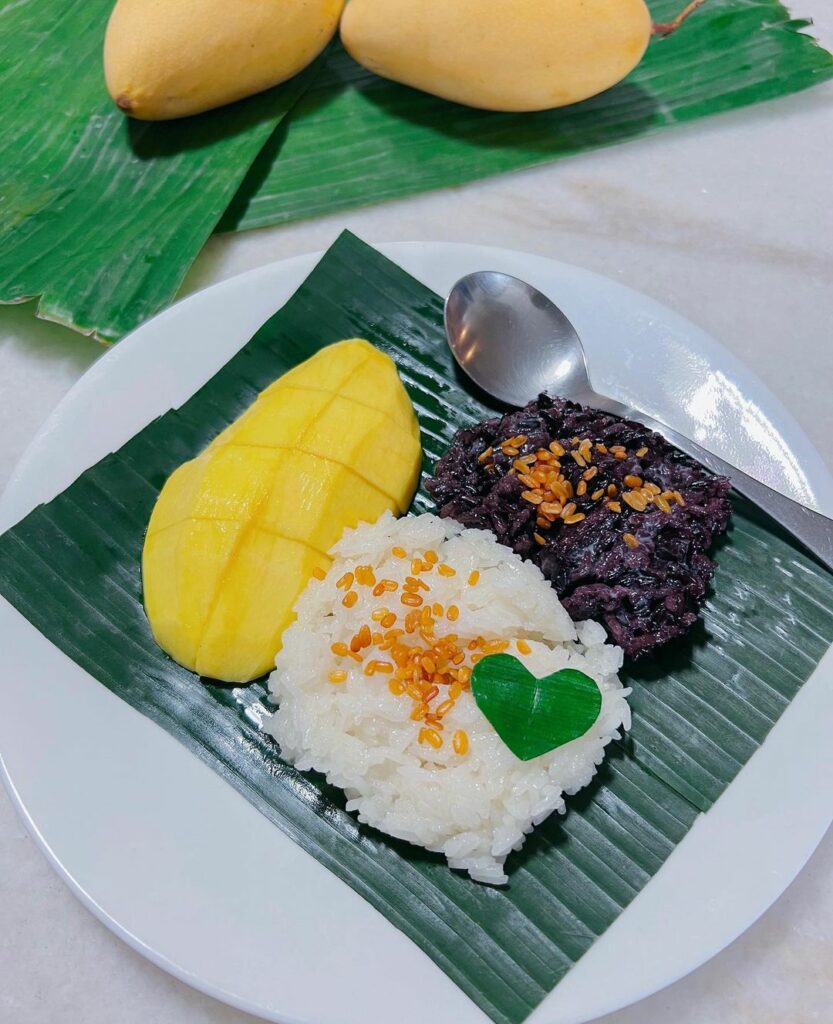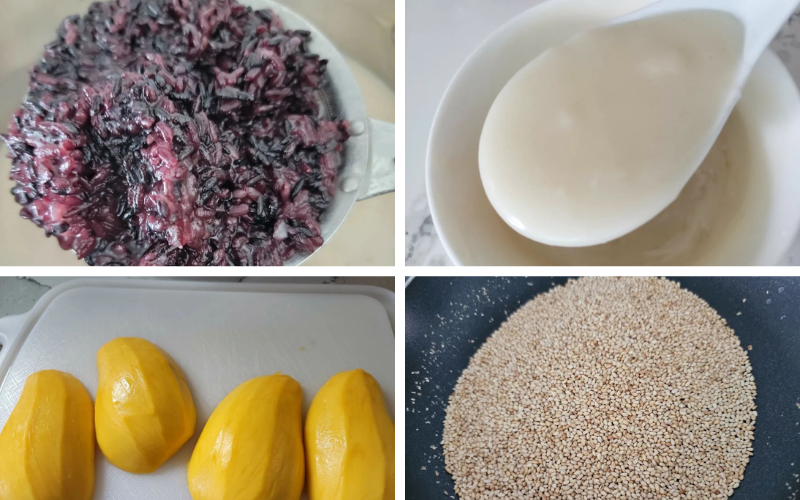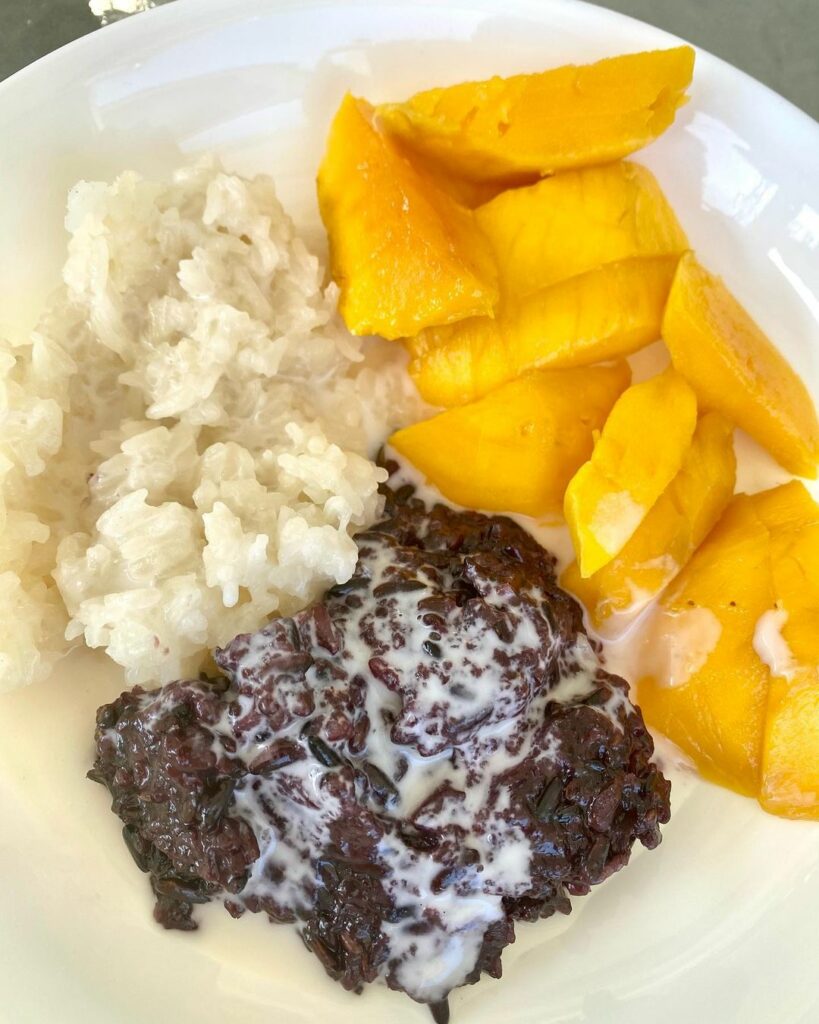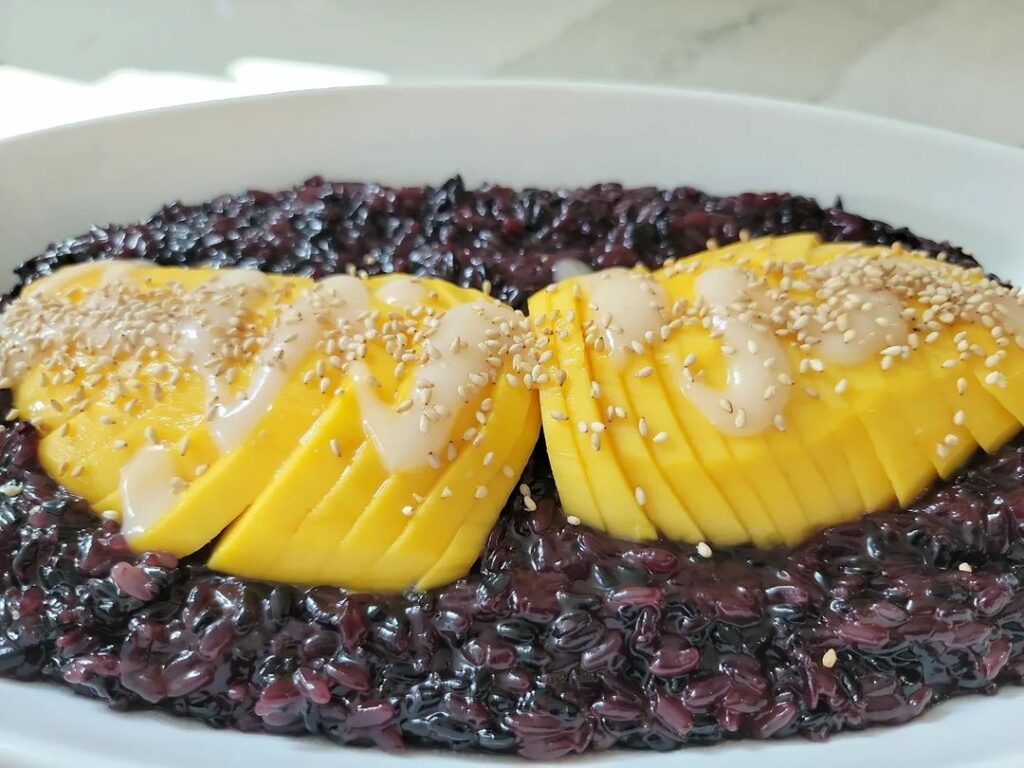As a lover of Asian cuisine, I was introduced to black sticky rice several years ago and have been hooked ever since. This unique rice has a nutty and slightly sweet flavor with a chewy texture that sets it apart from other types of rice.
What’s more, black sticky rice is a nutritious food that provides fiber, protein, and antioxidants. It’s a versatile ingredient that can be used in a variety of dishes, from sweet desserts to savory stir-fries.
I’m excited to share my knowledge and experience with others who are interested in exploring the delicious and nutritious world of black sticky rice.
What is black sticky rice?

Black sticky rice is a unique variety of rice that is popular in many cultures around the world. It is a type of glutinous rice that is known for its distinct black or dark purple color.
In many cultures, black sticky rice is considered to be a symbol of good fortune and is often used in special occasion dishes. It has a slightly sweet, nutty flavor and a sticky texture, making it a versatile ingredient in both sweet and savory dishes.
Black sticky rice is believed to have originated in Southeast Asia, particularly in Thailand, Laos, and Cambodia. It is grown in other parts of Asia as well, such as China and Japan. Over time, black sticky rice has become a staple food in many countries, with each culture developing its own unique ways of preparing and serving it.
In traditional dishes, black sticky rice is often used in desserts such as puddings, cakes, and sweet soups. It is also used in savory dishes such as stews, curries, and rice balls. In many cultures, black sticky rice is also used in special occasion dishes such as weddings and festivals.
Black sticky rice recipe

The black sticky rice recipe requires soaking the rice overnight before cooking.
Cooking note
- Yield: 4-6 servings
- Prep Time: 10 minutes, plus overnight soaking
- Cook Time: 30-35 minutes
- Total Time: 40-45 minutes, plus overnight soaking
- Course: Dessert
- Cuisine: Asian, Thai
- Equipment:
- Medium saucepan with lid
- Fine mesh strainer
- Rice cooker or steamer basket (optional)
Ingredients
- 1 cup black sticky rice
- 2 cups water
- 1/2 cup coconut milk
- 1/4 cup granulated sugar
- Pinch of salt
- Fresh mango slices or other fruit (optional, for serving)
How to cook black sticky rice?
To be able to cook black sticky rice easily and quickly, I will guide you step by step.
- Rinse the black sticky rice in a fine mesh strainer and place it in a bowl. Add enough water to cover the rice by about 1 inch and let it soak overnight.
- Drain the rice and rinse it again.
- In a medium saucepan, combine the rice and 2 cups of water. Bring to a boil over high heat, then reduce the heat to low, cover the saucepan with a lid, and simmer for 25-30 minutes, or until the rice is tender and most of the water has been absorbed.
- In a separate saucepan, combine the coconut milk, sugar, and salt. Heat over medium heat, stirring occasionally, until the sugar has dissolved and the mixture is smooth.
- When the rice is done, remove it from the heat and let it sit for 5-10 minutes. Then, fluff the rice with a fork and pour the coconut milk mixture over it. Stir gently to combine.
- If desired, serve the black sticky rice warm with fresh mango slices or other fruit.
Optional: This recipe can also be made in a rice cooker or steamer basket. Simply follow the manufacturer’s instructions for cooking sticky rice, and then proceed with step 5.
Common mistakes when cooking black sticky rice
Cooking black sticky rice can be tricky, especially if you’re not familiar with the cooking process. Here are some common mistakes to avoid when cooking black sticky rice:
- Not soaking the rice: Black sticky rice needs to be soaked overnight before cooking to ensure that it cooks evenly and has the proper texture. Skipping this step can result in undercooked or unevenly cooked rice.
- Using too much water: Black sticky rice should be cooked in a 2:1 ratio of water to rice. Using too much water can result in mushy, overcooked rice.
- Not using a lid: Black sticky rice needs to be cooked with a lid to trap in the steam and ensure that it cooks evenly. Cooking without a lid can result in undercooked rice.
- Cooking over high heat: Black sticky rice should be cooked over low heat to prevent the rice from burning or sticking to the pot. Cooking over high heat can result in burnt or unevenly cooked rice.
- Stirring too much: Black sticky rice should be stirred gently to prevent the rice from breaking apart or becoming too sticky. Stirring too much can result in a gummy, mushy texture.
- Not letting the rice rest: Once the rice is cooked, it should be allowed to rest for 5-10 minutes before fluffing with a fork. Skipping this step can result in a sticky, clumpy texture.
You have to avoid these common mistakes, you can ensure that your black sticky rice turns out perfectly cooked and delicious every time.
Tips and tricks to make the perfect black sticky rice
If you’re looking to make the perfect black sticky rice to enjoy, here are some tips and tricks to help you achieve the best results:
- Soak the rice overnight: Soaking the black sticky rice overnight helps to ensure that it cooks evenly and has the proper texture. This step is important, so don’t skip it!
- Use the right amount of water: Black sticky rice should be cooked in a 2:1 ratio of water to rice. This helps to ensure that the rice cooks evenly and has the proper texture.
- Cook over low heat: Black sticky rice should be cooked over low heat to prevent the rice from burning or sticking to the pot. This will also help the rice to cook evenly and absorb the water properly.
- Use a lid: Covering the pot with a lid helps to trap the steam and ensure that the rice cooks evenly. This will also help to prevent the rice from drying out.
- Stir gently: When stirring the rice, be gentle to avoid breaking the grains apart or making the rice too sticky. Use a fork to fluff the rice gently once it’s done cooking.
- Let the rice rest: After the rice is cooked, let it rest for 5-10 minutes before fluffing it with a fork. This will help the rice to absorb any remaining moisture and become perfectly tender.
- Add flavorings: Black sticky rice can be enhanced with various flavorings, such as coconut milk, sugar, or pandan leaves. Experiment with different flavor combinations to find your favorite.
How to store black sticky rice?
The best way to store and preserve black sticky rice is to keep it in an airtight container in a cool, dry place. Here are some tips for maintaining the quality and freshness of black sticky rice:
- Store uncooked black sticky rice in an airtight container in a cool, dry place, away from sunlight and moisture.
- Keep cooked black sticky rice in the refrigerator for up to 3-4 days in an airtight container.
- If you need to store cooked black sticky rice for a longer period, place it in a freezer-safe container and freeze it for up to 2-3 weeks.
To reheat cooked black sticky rice, place it in a microwave-safe container with a small amount of water or coconut milk and heat in the microwave for 1-2 minutes, stirring occasionally.
If the black sticky rice has dried out, you can add a little bit of water or coconut milk to moisten it before reheating.
How many calories in black sticky rice?

Black sticky rice is a nutritious alternative to other types of rice, as it contains unique health benefits and nutritional value. Here’s a closer look at the nutritional information for black sticky rice:
One cup of cooked black sticky rice (165 grams) contains approximately:
| Nutrient | Amount |
| Calories | 248 |
| Protein | 4.3 grams |
| Fat | 1.6 grams |
| Carbohydrates | 54.5 grams |
| Fiber | 2.8 grams |
| Sugar | 0.7 grams |
Is black sticky rice healthy?
Black sticky rice is also a good source of vitamins and minerals, including:
- Thiamin (B1)
- Niacin (B3)
- Vitamin B6
- Iron
- Magnesium
- Phosphorus
- Zinc
- Manganese
So, is black sticky rice healthy? Absolutely, black sticky rice is good for health, but you have to eat black sticky rice amount of. The unique nutritional benefits of black sticky rice compared to other types of rice include a lower glycemic index, which means that it has less of an impact on blood sugar levels. This can help with weight management and reduce the risk of diabetes.
Black sticky rice also contains antioxidants called anthocyanins, which are responsible for its dark color. These antioxidants may help protect against chronic diseases such as cancer, heart disease, and Alzheimer’s disease.
To incorporate black sticky rice into a healthy diet, try using it as a replacement for other types of rice in dishes such as stir-fries, salads, and soups. You can also use it in place of other grains in recipes such as grain bowls and pilafs.
Black sticky rice can also be used in sweet dishes such as puddings and cakes, but be mindful of the added sugar and calories in these types of desserts.
Varieties of black sticky rice
Black sticky rice is a versatile ingredient that comes in several different varieties, each with its own unique characteristics and flavor profiles. Here’s a closer look at some of the most popular types of black sticky rice:
- Black grlutinous rice: This is the most common type of black sticky rice, with a deep puple-black color and a slightly sweet, nutty flavor. It is commonly used in sweet dishes such as rice puddings and cakes.
- Black sweet rice: This type of black sticky rice is even sweeter than black glutinous rice, with a sticky, chewy texture. It is often used in desserts and sweet soups.
- Black riceberry: This variety of black sticky rice is a hybrid of black glutinous rice and Thai jasmine rice. It has a slightly nutty flavor and is often used in savory dishes such as curries and stews.
- Forbidden black rice: This type of black sticky rice is also known as “forbidden rice” because it was once reserved for Chinese royalty. It has a deep, rich flavor and a slightly chewy texture, and is often used in both sweet and savory dishes.
- Black japonica rice: This variety of black sticky rice has a black outer layer and a white center. It has a slightly nutty flavor and a fluffy texture, making it a versatile ingredient in both sweet and savory dishes.
When choosing the best type of black sticky rice for your needs, consider the flavor and texture you’re looking for, as well as the dish you plan to make. Some types of black sticky rice are better suited for sweet dishes, while others are ideal for savory dishes.
When preparing different types of black sticky rice, be sure to follow the cooking instructions carefully, as the cooking time and water ratio can vary depending on the type of rice. Some types of black sticky rice may also require soaking before cooking.
What to serve with black sticky rice?

Black sticky rice can be served with a variety of dishes, both sweet and savory. Here are some ideas for what to serve with black sticky rice:
- Thai curries: Black sticky rice Thai pairs well with spicy Thai curries, such as red curry or green curry. The sticky texture of the rice helps to absorb the flavorful curry sauce.
- Grilled meats: Black sticky rice is a great side dish for grilled meats, such as chicken or pork. The nutty flavor of the rice complements the smoky flavor of the grilled meat.
- Stir-fries: Use black sticky rice as a base for a stir-fry with vegetables and protein. The sticky texture of the rice helps to bind the stir-fry together.
- Sweet desserts: Black sticky rice is often used in sweet desserts, such as rice pudding or sweet rice cakes. Serve black sticky rice dessert with fresh fruit or a drizzle of coconut milk for a delicious and satisfying dessert like coconut black sticky rice.
- Savory salads: Use black sticky rice as a base for a hearty salad, with vegetables, nuts, and a flavorful dressing. The chewy texture of the rice adds a satisfying crunch to the salad.
- Black sticky rice in beverages: Black sticky rice can also be used to make a variety of beverages, including tea and cocktails. You can make black sticky rice tea by steeping the cooked rice in hot water with ginger and honey, or use it as a base for a Thai iced tea. For a unique cocktail, try mixing black sticky rice-infused rum with pineapple juice and lime.
How much does black sticky rice cost?
Black sticky rice is typically priced higher than other types of rice due to its unique characteristics and health benefits. On average, black sticky rice can cost around $6 to $8 per pound. However, prices may vary depending on the brand and location.
Buying black sticky rice in bulk can often save you money in the long run. A 5-pound bag of black sticky rice can cost between $19 and $28, depending on the brand and quality.
Keep in mind that the price of black sticky rice may also be affected by factors such as the growing season, availability, and import/export tariffs. It’s always a good idea to shop around and compare prices before making a purchase.
FAQs
Is black sticky rice gluten-free?
Black sticky rice is naturally gluten-free, making it a great option for people with gluten sensitivities or celiac disease.
Can black sticky rice help with weight loss?
While black sticky rice is a nutritious food that can provide fiber and other important nutrients, it alone is not a weight loss solution. However, incorporating black sticky rice into a healthy and balanced diet can be a part of an overall weight loss plan.
Black sticky rice is high in fiber, which can help you feel full and satisfied and can also help regulate blood sugar levels. Additionally, the unique nutty and slightly sweet flavor of black sticky rice can make it a satisfying and delicious addition to meals, helping you feel more satisfied and potentially reducing the desire to overeat.
What is the glycemic index of black sticky rice?
The glycemic index (GI) of black sticky rice is relatively low compared to other types of rice, with an average GI value of 68. This is due to the high fiber content in black sticky rice, which helps to slow down the absorption of glucose into the bloodstream.
Foods with a lower glycemic index are generally considered healthier choices for people with diabetes or those trying to manage blood sugar levels. However, it’s important to note that the GI value of black sticky rice can vary depending on factors such as the cooking method and serving size, so it’s always a good idea to consult a healthcare professional for personalized dietary advice.
Is black sticky rice suitable for vegans and vegetarians?
Yes, black sticky rice is suitable for vegans and vegetarians as it is a plant-based food that does not contain any animal products. Black sticky rice is a great source of complex carbohydrates, fiber, and plant-based protein, making it a nutritious addition to any vegan or vegetarian diet.
Additionally, black sticky rice is versatile and can be used in a variety of dishes, from savory stir-fries to sweet desserts, making it a great ingredient for plant-based cooking.
How is black sticky rice different from other types of rice?
Black sticky rice is different from other types of rice in several ways. First, it has a darker color due to the natural pigments in the rice. It also has a slightly sweet and nutty flavor with a chewy texture.
Additionally, black sticky rice is higher in fiber, protein, and antioxidants than many other types of rice, making it a more nutritious option.
Is black sticky rice difficult to find in stores?
While black sticky rice may be less common than other types of rice, it is becoming more widely available in specialty grocery stores and online retailers. It may also be labeled as “black glutinous rice” or “forbidden rice.”
In addition, you can find websites to buy black sticky rice, sometimes few websites have a lot of promotions for buyers. There are several websites that sell black sticky rice online. Here are a few options:
- Amazon: Amazon offers a variety of brands and types of black sticky rice, as well as bulk purchasing options.
- Thrive Market: Thrive Market offers a selection of organic and non-GMO black sticky rice options for purchase.
- iHerb: iHerb carries a range of black sticky rice brands and offers international shipping options.
- Walmart: Walmart offers a variety of black sticky rice brands for purchase online, with options for in-store pickup or delivery.
- Asian Food Grocer: This online retailer specializes in Asian groceries and offers a selection of black sticky rice options.
When purchasing black sticky rice online, be sure to check reviews and compare prices and shipping options to ensure you are getting the best deal.
Can black sticky rice be used as a substitute for other grains?
Black sticky rice can be used as a substitute for other grains in some recipes, such as in salads, grain bowls, and desserts.
However, it may not be suitable as a direct replacement for other types of rice in every recipe, as its unique texture and flavor may affect the overall outcome. Experiment with different recipes and substitutions to find the best fit for your needs.
Conclusion
In the end, black sticky rice is a unique and nutritious ingredient that has been a staple in traditional Asian cuisine for centuries. With its nutty and slightly sweet flavor, chewy texture, and dark color, black sticky rice is a versatile ingredient that can be used in a variety of dishes, from sweet desserts to savory stir-fries.
When cooking black sticky rice, it’s important to follow the proper steps and avoid common mistakes to ensure that the rice turns out perfectly cooked and delicious. Soaking the rice overnight, using the right amount of water, cooking over low heat, and letting the rice rest are all important steps to achieving the perfect texture and flavor.
Black sticky rice is also a nutritious food that can provide fiber, protein, antioxidants, and other important nutrients. It is naturally gluten-free, making it a great option for people with gluten sensitivities or celiac disease.
While black sticky rice may be less common than other types of rice, it can be found in specialty grocery stores and online retailers. You should experiment with different types and recipes to find your favorite way to enjoy this delicious and nutritious ingredient.
More dessert recipes in Vietnam